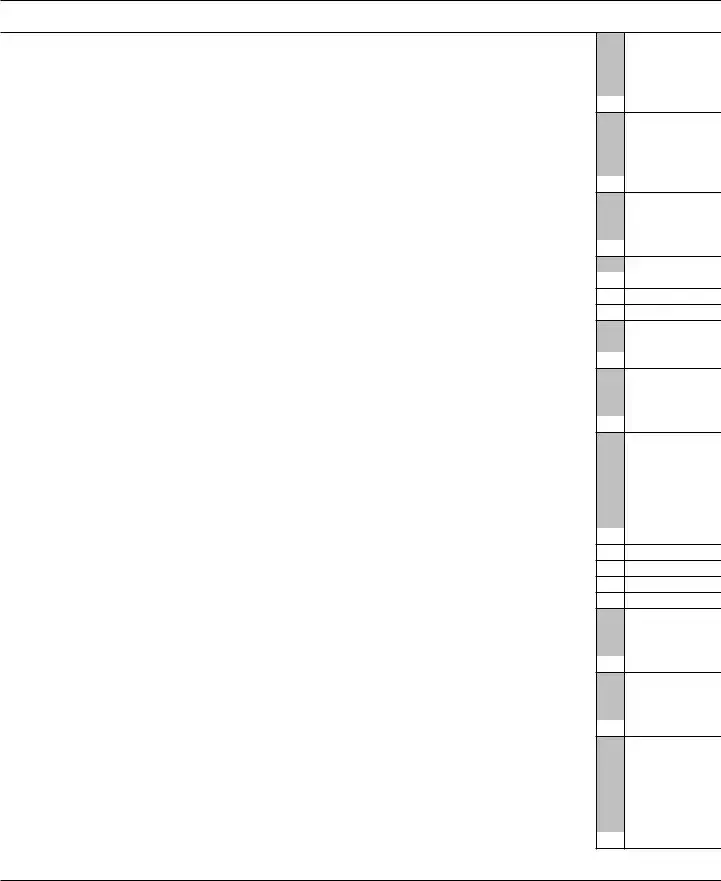Caution: If you didn’t complete the 2020 Qualified Dividends and Capital Gain Tax Worksheet, the 2020 Schedule D Tax Worksheet, or Part V of the 2020 Schedule D (Form 1041), see the instructions before completing this part.*
27Enter the amount from Form 8801, line 10. If you filed Form 2555 for 2020, enter the amount from line
3 of the Foreign Earned Income Tax Worksheet in the instructions . . . . . . . . . . . .
Caution: If for 2020 you filed Form 1041 or 2555, see the instructions before completing lines 28, 29, and 30.
28Enter the amount from line 4 of your 2020 Qualified Dividends and Capital Gain Tax Worksheet, the amount from line 13 of your 2020 Schedule D Tax Worksheet, or the amount from line 26 of the 2020
Schedule D (Form 1041), whichever applies (as refigured for the AMT, if necessary)* . . . . . .
If you figured your 2020 tax using the 2020 Qualified Dividends and Capital Gain Tax Worksheet, skip line 29 and enter the amount from line 28 on line 30. Otherwise, go to line 29.
29Enter the amount from line 19 of your 2020 Schedule D (Form 1040), or line 18b, column (2), of the
2020 Schedule D (Form 1041) . . . . . . . . . . . . . . . . . . . . . . . .
30Add lines 28 and 29, and enter the smaller of that result or the amount from line 10 of your 2020
Schedule D Tax Worksheet . . . . . . . . . . . . . . . . . . . . . . . . .
31 |
Enter the smaller of line 27 or line 30 |
32 |
Subtract line 31 from line 27 |
33If line 32 is $197,900 or less ($98,950 or less if married filing separately for 2020), multiply line 32 by 26% (0.26). Otherwise, multiply line 32 by 28% (0.28) and subtract $3,958 ($1,979 if married filing
|
separately for 2020) from the result |
. . . . . . . . ▶ |
34 |
Enter: |
} |
|
|
• $80,000 if married filing jointly or qualifying widow(er) for 2020, |
. . . . . . . |
|
• $40,000 if single or married filing separately for 2020, |
|
• $53,600 if head of household for 2020, or |
|
• $2,650 for an estate or trust.
35Enter the amount from line 5 of your 2020 Qualified Dividends and Capital Gain Tax Worksheet, the
|
amount from line 14 of your 2020 Schedule D Tax Worksheet, or the amount from line 27 of the 2020 |
|
Schedule D (Form 1041), whichever applies. If you didn’t complete either worksheet or Part V of the 2020 |
|
Schedule D (Form 1041), enter the amount from your 2020 Form 1040, 1040-SR, or 1040-NR, line 15, or |
|
2020 Form 1041, line 23, whichever applies; if zero or less, enter -0- |
36 |
Subtract line 35 from line 34. If zero or less, enter -0- |
37 |
Enter the smaller of line 27 or line 28 |
38 |
Enter the smaller of line 36 or line 37 |
39 |
Subtract line 38 from line 37 |
40 |
Enter: |
} |
|
|
• $441,450 if single for 2020, |
|
|
• $248,300 if married filing separately for 2020, |
|
|
• $496,600 if married filing jointly or qualifying widow(er) for 2020, |
. . . . . . . |
|
• $469,050 if head of household for 2020, or |
|
41 |
• $13,150 for an estate or trust. |
|
Enter the amount from line 36 |
42Form 1040, 1040-SR, or 1040-NR filers, enter the amount from line 5 of your 2020 Qualified Dividends and Capital Gain Tax Worksheet or the amount from line 21 of your 2020 Schedule D Tax Worksheet, whichever applies. If you didn’t complete either worksheet, see instructions. Form 1041 filers, enter the amount from line 27 of your 2020 Schedule D (Form 1041) or line 18 of your 2020 Schedule D Tax Worksheet, whichever applies. If you didn’t complete either the worksheet or Part V of the 2020
Schedule D (Form 1041), enter the amount from your 2020 Form 1041, line 23; if zero or less, enter
-0-. |
. |
. |
. |
. |
. |
. |
. |
. |
. |
. |
. |
. |
. |
. |
. |
. |
. |
. |
. |
. |
. |
. |
. |
. |
. |
. |
. |
. |
. |
. |
. |
. |



